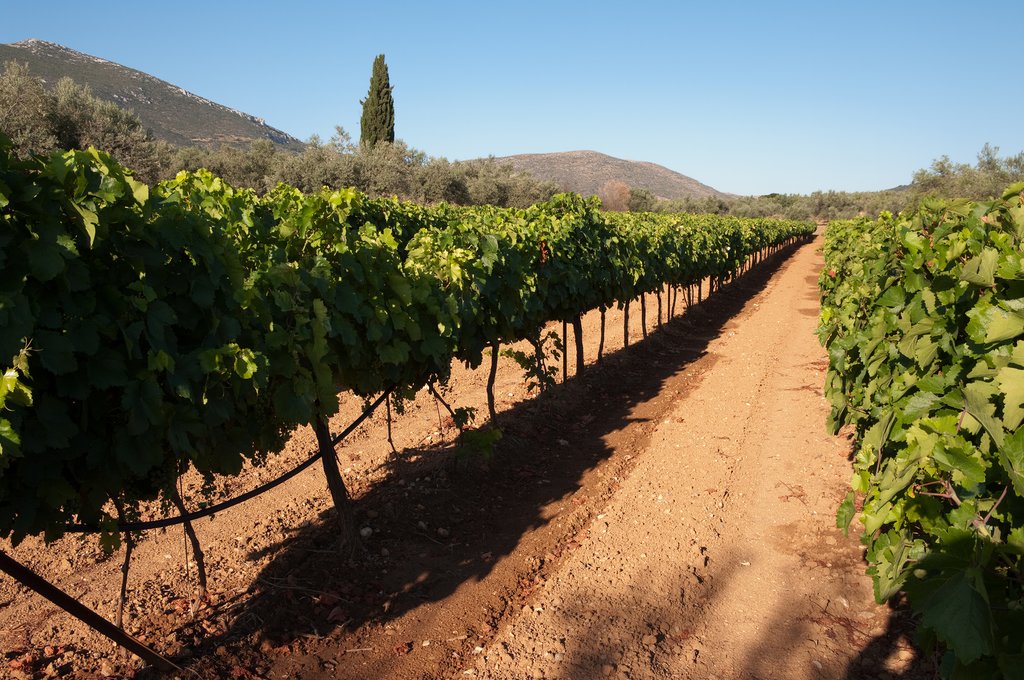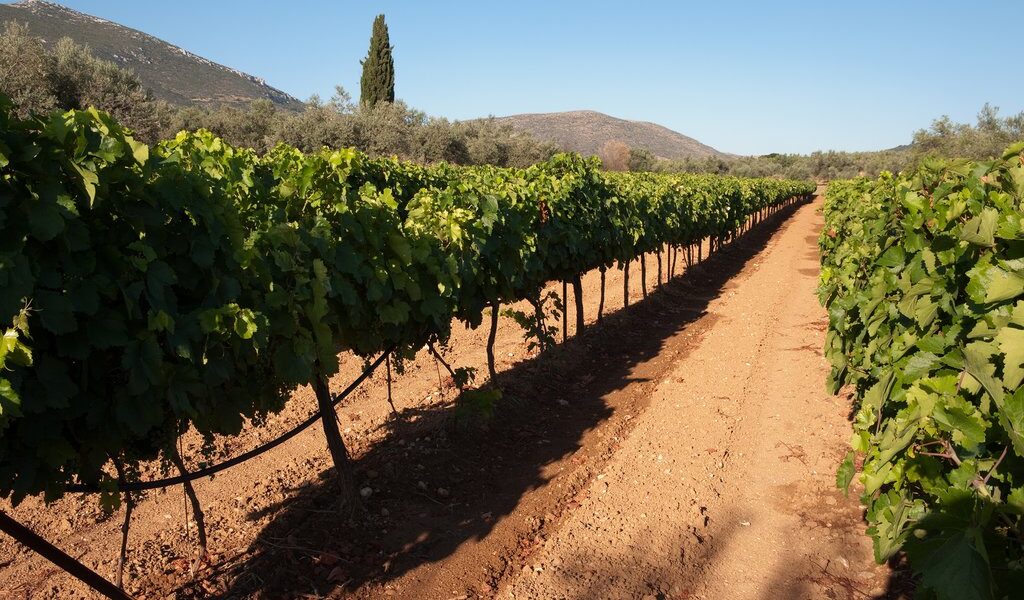
Greece is one of the oldest wine-producing areas in the world. Sip dry white wine on Santorini, sample rosé on a Peloponnese road trip, try sparkling wines in the mountainous north, or discover the reds of Crete: there is something for every taste. Learn more about the key destinations with this guide.
## Greece’s Wine Regions: A Comprehensive Exploration
The deep-rooted connection between Greeks and wine stretches back through the millennia, forming an integral part of their cultural heritage. While archaeological discoveries suggest that the earliest wine production occurred in China, Greece quickly followed suit. The ancient Greeks initiated the art of grape crushing as early as 4500 BCE, a practice that would later extend to their colonies situated in what we now recognize as Italy, France, and Spain. Even though Greek wines might not command the same global recognition as renowned wines like Bourdeaux or Barolo, the production and consumption of wine remain a vibrant and vital aspect of Greek national identity.
Across the Greek mainland and its numerous islands, you’ll discover a delightful array of wine regions, each offering its unique character and flavor profiles. Many visitors, while enjoying their vacations on the captivating island of Santorini, will undoubtedly encounter the refreshing white wines like Assyrtiko. Similarly, those exploring the historical city of Athens may become acquainted with the aromatic Retsina varietals. However, the Greek wine scene offers so much more than these popular choices. This guide provides a detailed overview of the country’s principal wine regions, categorized into four distinct areas: Central, South, North, and the Aegean Islands, assisting you in planning your wine-infused travels.
Central Greece, Northern Greece, Southern Greece and the stunning Aegean Islands each offer unique landscapes, local flavors, and unforgettable experiences.
## Central Greece: A Journey Through History and Vineyards
For many first-time visitors, their introduction to Greek wine often occurs in Central Greece, a region encompassing both Attica and Thessaly, often without them even realizing it. This is primarily because Athens, the capital city, is located within this region, and numerous restaurants proudly serve locally produced wines. The bustling capital is an integral part of the historic wine-producing region of Attica, also known as the Attic Peninsula. This is the legendary location where, according to Greek mythology, Dionysus, the god of wine, introduced the art of winemaking to the mortal Icarius.
Within Attica’s warm and arid climate, the most celebrated wine is undoubtedly Retsina. This distinctive wine, traditionally infused with sap sourced from the Aleppo pine tree, boasts a history dating back to the 2nd century BCE. While it’s sometimes considered an acquired taste, contemporary bars and restaurants are increasingly offering more approachable and palatable versions of this resinous varietal. These newer versions often feature Savatiano, Greece’s most widely cultivated white grape. Venturing further north into Thessaly, which is also part of the central region, you’ll encounter vineyards at higher elevations near the base of the majestic Mount Olympus, where Cabernet Sauvignon and other red wines are produced.
Several travel agencies provide specialized wine-focused day tours departing from Athens. These tours typically combine wine tastings at local wineries with visits to significant archaeological sites, offering a rich blend of culture and flavor. Highly recommended wineries in the area include Mylonas, Anastasia Frangos, Papagiannakos, and the esteemed Kokotou Estate.
Consider planning your visit to this region in September for an ideal experience. The advantages of exploring Greece in early autumn offer a unique and pleasant travel experience.
## Aegean Islands: Wine Tasting with Stunning Sea Views
Imagine savoring the charm of a Greek island, framed by the iconic postcard-perfect views of whitewashed houses cascading down hillsides and the deep blue expanse of the ocean. What better way to complement this idyllic scene than with a glass of chilled, crisp white wine? The Aegean Sea is adorned with numerous islands, each boasting a wine production history that stretches back thousands of years.
On the enchanting island of Santorini, the most celebrated varietal is undoubtedly Assyrtiko, a white wine characterized by its refreshing notes of lemon and passion fruit. To expand your palate, consider comparing it with Nykteri, an oaked version of the same wine, during a tasting at a local winery such as Vassaltis Vineyards, where wine tastings are thoughtfully paired with locally produced cheeses. Consider a guided tour of Santorini, that thoughtfully combines a visit to the island’s highest peak, stops in charming medieval villages such as Megalochori and Pyrgos, and a delightful tasting of local wines.
Venturing to the volcanic island of Limnos, you’ll discover a distinctive red wine known as Limnio, also referred to as Kalampaki, a local classic with a rich history. This wine, considered one of the oldest Greek varieties, was said to be a favorite of Aristotle himself. Muscat of Alexandria, a sweet wine, is another delightful option to explore. To gain more insight into the island’s wineries, consider contacting Lemnos Wine Trails for information. Recommended stops include Savoglou-Tsivolas (Lemnos Organic Wines) and Ktima Chatzigeorgiou in Karpasi.
For those who appreciate the allure of muscat, a sweet fortified wine, a visit to the island of Samos is a must. Samos is celebrated as the birthplace of Muscat Blanc, an exquisitely aromatic white muscat. Begin your exploration at the Samos Wine Museum, where you can sample local varietals and immerse yourself in the island’s captivating viticultural history. Afterward, venture to Vakakis Winery, a small organic winery located just outside the town of Karlovassi, for an enriching tour and tasting experience.
## Northern Greece: Discovering Unique Terroirs
The northernmost region of Greece, which shares borders with Albania, Bulgaria, and Turkey, presents a climate that is notably colder and wetter compared to the rest of the country. This distinctive climate is reflected in the wines produced in this region.
In the mountainous area of Zitsa, situated in the northwest region of Epirus, sparkling wines take center stage. Look for a delightful pink sparkling wine with notes of cherry and strawberry at Zoinas Winery, as well as a traditional semi-sparkling wine known as Debina at Domaine Glinavos.
Moving into Macedonia, located in the central north, you’ll find exceptional sparkling wines at renowned wineries like Domaine Karanikas and Apostolos Matamis. The region is also known for producing full-bodied red wines in the areas of Naoussa and Amyndeo, with Xinomavro taking the spotlight. This varietal boasts enticing aromas of dark cherry and licorice. To experience Xinomavro at its finest, consider visiting Moraitis Winery, Elinos, or Boutari Winery, all located along the developing Wine Route of Naoussa.
In the vicinity of Thessaloniki, in the northeast, be sure to sample the unusually rich white wine, Malagousia, at Gerovassiliou Winery. As in other parts of Greece, Assyrtiko is widely popular here. Additionally, you’ll encounter blends that incorporate more conventional white grapes like Sauvignon Blanc and Chardonnay in the historic wine-growing region of Thrace, which extends into both Turkey and Bulgaria.
## Southern Greece: Mediterranean Flavors
Southern Greece, blessed with a warm and sunny climate, epitomizes a classic Mediterranean-style wine-growing region. Here, you’ll have the opportunity to discover an array of crisp white wines, such as Moschofilero, cultivated in Mantineia. You can also savor rosé wines crafted from the Agiorgitiko grape in Nemea, within the Peloponnese region. Don’t miss the chance to explore lesser-known red wines like Liatiko on the beautiful island of Crete.
On the island of Kefalonia, nestled in the Ionian Sea southwest of the mainland, winemaking traditions have flourished since ancient times. While white muscat is widely grown and enjoyed here, the signature wine to seek out is Robola, a medium-bodied white characterized by its delightful notes of pineapple and lemon. Melissinos Winery and Menousis Wines are two notable wineries on the island where you can sample this unique varietal.
Traveling further east into the Peloponnese, be sure to explore the Corinthia Wine Roads. This network features several recommended routes that meander through the wine-growing region of Nemea, guiding travelers to a diverse selection of local wineries. Some wineries include Domaine Repanis, Zacharias Vineyards, and Bizios Estate. Along the way, you’ll pass geographic highlights such as Lake Stymfalia and the Asopos River, enhancing your journey. As you explore, keep an eye out for Agiorgitiko, a fruity red wine with enticing aromas of black currant and raspberry, as well as Roditis, a bright white wine that offers refreshing notes of melon and lime.
The winery scene on Crete is both extensive and deeply rooted in the island’s history. Popular varietals here include Vidiano, a dry white wine, and Liatiko, an unusual red wine with notes of rose and cherry. Numerous travel agencies offer wine-themed tours of the island, or you can choose to visit wineries independently. Consider making stops at Manousakis Winery, near Vatolakkos, Douloufakis Winery, located outside of Heraklion, and Rhous Winery, which produces organic wines amidst the stunning island scenery in Houdetsi. This comprehensive exploration promises an unforgettable experience for wine enthusiasts and travelers alike.
B-1032

